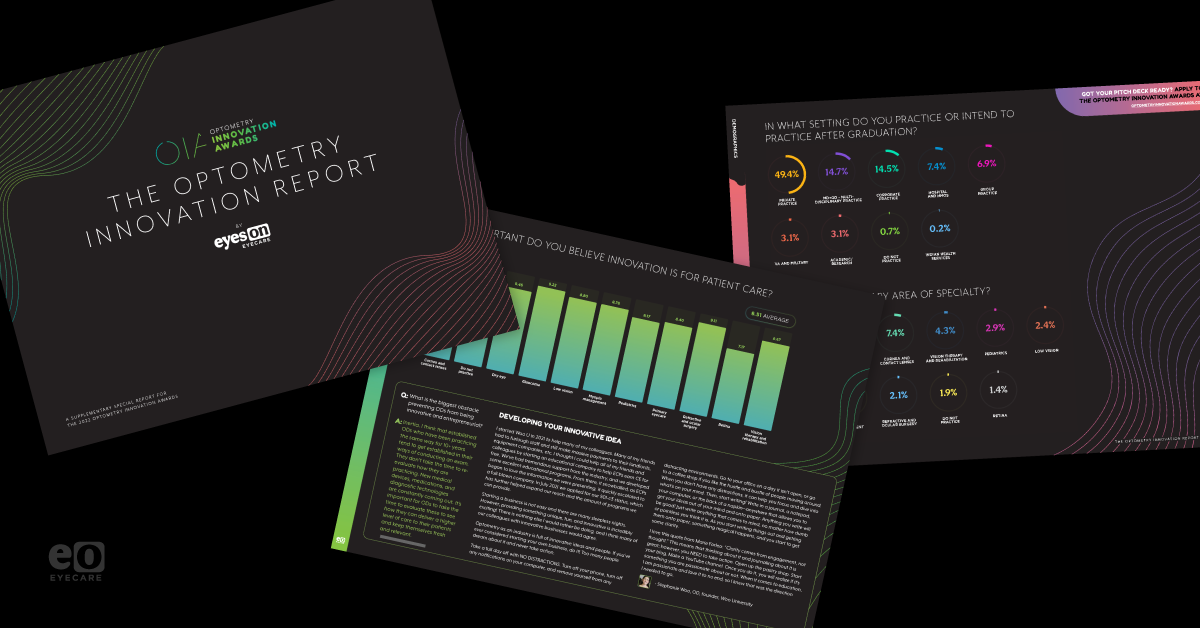Inventor Thomas Edison once said, “There’s a way to do it better—find it.“ This mindset is the driving force behind innovation in all fields, and optometry is no exception.
Innovators are invaluable, as they find new solutions to pressing problems. As clinicians, you know the obstacles you and your colleagues face every day and, maybe, you have a great idea for solving one of the many consistent concerns in optometry.
With our 2022 Optometry Innovation Awards (OIA), we promoted the pursuit of innovative and entrepreneurial ideas within the field and honored optometric professionals who made revolutionary contributions. Our inaugural winner was Janelle Davison, OD, whose cloud-based Paradeyem Optical Software provides practices with a means to boost revenue and improve efficiency by tracking key metrics.
Alongside the award, we published the 2022 Optometry Innovation Report, which gauged the interest in innovation of 421 optometrists and optometry students. Our findings were fascinating.
Here are some of the top trends and most common beliefs about the state of innovation in eyecare.
Download the 2022 Optometry Innovation Report!
🧑🚀
2022 Optometry Innovation Report
Featuring survey responses from fellow ODs, learn what your colleagues think about the future of innovation in optometry and pearls for starting an eyecare business.
Innovation is intrinsic to improved patient care
Overall, optometrists ranked the importance of innovation for patient care at an average of 8.51/10 and the importance of innovation for practice success at an average of 8.48/10.
It was deemed that innovation was most important in the areas of cornea and contact lens (9.23/10) and glaucoma (9.22/10), with refractive and ocular surgery (9.11/10) coming in at a close third. Retina (7.17) was where ODs felt the least innovation was required. However, 29.9% of those surveyed felt dry eye held the largest opportunity for eyecare in the future.
ODs are quick adopters
Optometrists are excited for new innovations and relatively quick to incorporate new technologies into their practice. Though a plurality of optometrists (185/421) classified themselves as “neither early nor late adopters” of new innovations, 175 declared themselves as either extremely early or early adopters.
However, when asked to rank their awareness of upcoming pharmaceuticals that were currently in development or in the Food and Drug Administration (FDA) approval pipeline, respondents scored a mediocre 5.2/10 average.
Myopia management is the most innovative specialty
Though the vast majority acknowledged the importance of innovation and were relatively quick to adopt, they felt only 6.24/10 optometrists in their specialty were especially innovative.
Yet, specialists in two particular fields were thought to be the most inventive and leading edge: those dedicated to myopia management and cornea and contact lenses, who were ranked by their peers at 7.89/10 and 7.32/10, respectively.
Obstacles to innovation
Three culprits topped the list of why optometrists felt they could not fulfill their entrepreneurial and innovative potential: time, money, and fear. Many felt that, with their obligations to career and family, there just were not enough hours in the day to dedicate to innovative pursuits.
As to money, the overwhelming weight of student loans, cost-of-living expenses, and other financial concerns also played a major role. Lastly, fear—of the unknown, change, and losing patients due to time spent outside of direct patient care—was top of mind for many optometrists. Nonetheless, even with these challenges, we believe investing in innovations is well worth it.
Do you have that next big idea?
Optometry is an industry rich in—and ripe for—innovation. Over the last decade, the market size of the US optometry industry has grown faster than the overall healthcare industry, keeping a steady pace with the US economy.1
That is why, along with these valuable statistics, the Optometry Innovation Report also offers tips, advice, and recommendations from industry innovators. According to respondents, diagnostics, insurance billing and coding, software and technology, and education present the greatest opportunities for launching the next big idea.
Each year, we see our colleagues in the eyecare industry come up with techniques and technologies to drive the industry forward. If you have a revolutionary concept or pioneering product, we hope we have encouraged you to take that next step toward making your own daring dream into a rich reality.
